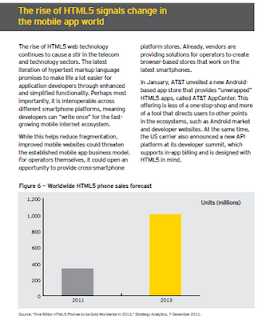 A whitepaper on Alcatel-Lucent's site called 'How to Build Killer Apps for Mobile Networks' has some good advice for developers looking to create apps for the 4G platform, which is the big-daddy of spectrums that is going to make streaming of media-rich websites and applications, a seamless and non-frustrating experience. Here are excerpts about how to enable long term evolution (LTE), which is the dominant 4G technology, to work flawlessly while your apps get used.
A whitepaper on Alcatel-Lucent's site called 'How to Build Killer Apps for Mobile Networks' has some good advice for developers looking to create apps for the 4G platform, which is the big-daddy of spectrums that is going to make streaming of media-rich websites and applications, a seamless and non-frustrating experience. Here are excerpts about how to enable long term evolution (LTE), which is the dominant 4G technology, to work flawlessly while your apps get used.1. PLAN FOR A MIX OF 2G, 3G AND LTE USE: Give your app the ability to make an intelligent decision about how to fetch data, depending on the network and radio resources available. If your app relies on constant network connectivity, periodically have your app check both bandwidth and latency to make a smart decision to adapt dynamically no matter what kind of network it is on, and have your app adjust accordingly.
2. SPEED RESULTS WITH PRE-FETCHING: In many situations data retrieval needs can be anticipated with pre-fetching. By giving your application a way to access necessary data before it is requested by the user, you can provide an even more seamless user experience. If you expect that users will be making many data-intensive requests that have to go through the network to a server, invest some effort in creating a pre-fetching system.
3. CACHE MORE OFTEN: By caching extensively you can increase the responsiveness of your application and eliminate the spikes in network requests that cause user-discernable performance problems. Spikes in network activity typically occur at predictable times. Think about how and when your app needs data, and if possible cache in advance of periods of high network activity.
4. CREATE ONE SESSION WITH MULTIPLE ”GETS”: If you can group requests to remote servers into one session, you’ll be able to take better advantage of higher bandwidth and longer sessions.
5. TAKE ADVANTAGE OF LTE’S ALL-IP CAPABILITIES: Because LTE can go from idle to active in 100 ms, your application can provide an always-on experience without actually being active at all times. LTE’s ability to deliver a variety of media concurrently means that you can start one stream while stopping another. For example, an app could display a scrolling map while simultaneously delivering voice-over narration without startup hesitation or playback stutter.
 6. AVOID POLLING ON DEMAND REQUESTS: The first batch of LTE-ready mobile devices may consume more battery power because monitoring both LTE and 2G/3G networks at the same time. By reducing polling, you can conserve battery power.
6. AVOID POLLING ON DEMAND REQUESTS: The first batch of LTE-ready mobile devices may consume more battery power because monitoring both LTE and 2G/3G networks at the same time. By reducing polling, you can conserve battery power.7. FAVOR DOWNLOADING OVER STREAMING: Continuous streaming also appears to drain batteries at a higher rate than downloads. And in areas with slower networks, batteries get depleted faster because the device boosts its network reception in order to overcome network noise.
8. USE A BIGGER BUFFER: When a user pulls down streaming media or initiates a download from your app while on an LTE network and for some reason is switched to a 3G network, the effect on the user can be minimized through the use of a large data buffer. Because LTE already pulls down data more quickly, it is a good idea to use a bigger buffer than you would on a 3G network. This will not create a noticeable performance hit on LTE networks, and will minimize the impact of user movement between LTE and 3G networks.
9. AVOID AGGRESSIVE BEHAVIOR: Apps that live in an Radio Frequency (RF) environment and have to operate on a crowded wireless network need to be good citizens. If packet loss occurs, a device needs to back off orwait for response. If your app is continuously attempting to regain lost packets, it can exacerbate the original failure conditions, degrading or denying service to other devices and congesting traffic.
An Ernst and Young report highlighted the rise of HTML5 as well, which will help synchronise apps and websites across smart devices. The above graphic says it all.
Source: Ernst&Young - Look at page 10 of this report for the above graphic http://www.ey.com/Publication/vwLUAssets/Inside_Telecommunications_4Q_2011/%24FILE/Quarterly%20talking%20points%20from%20EY.pdf
